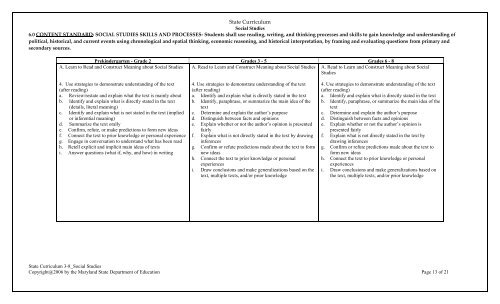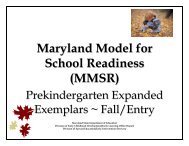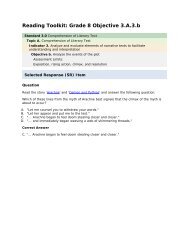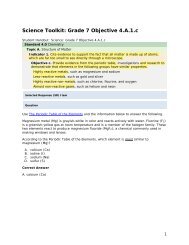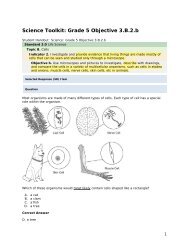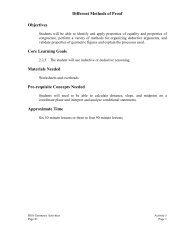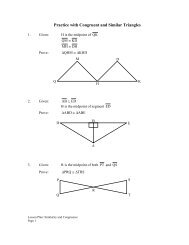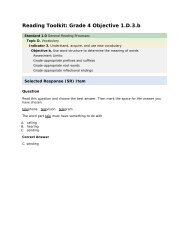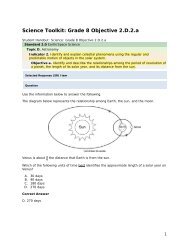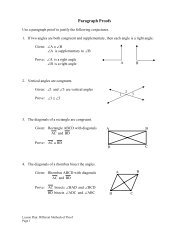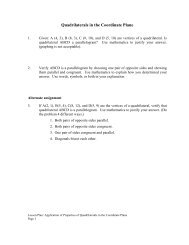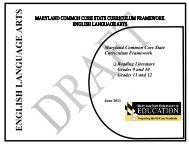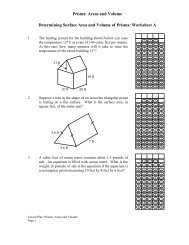Maryland State Curriculum - mdk12
Maryland State Curriculum - mdk12
Maryland State Curriculum - mdk12
- TAGS
- maryland
- curriculum
- mdk12.org
You also want an ePaper? Increase the reach of your titles
YUMPU automatically turns print PDFs into web optimized ePapers that Google loves.
<strong>State</strong> <strong>Curriculum</strong><br />
Social Studies<br />
6.0 CONTENT STANDARD: SOCIAL STUDIES SKILLS AND PROCESSES‐ Students shall use reading, writing, and thinking processes and skills to gain knowledge and understanding of<br />
political, historical, and current events using chronological and spatial thinking, economic reasoning, and historical interpretation, by framing and evaluating questions from primary and<br />
secondary sources.<br />
Prekindergarten - Grade 2 Grades 3 - 5 Grades 6 - 8<br />
A. Learn to Read and Construct Meaning about Social Studies A. Read to Learn and Construct Meaning about Social Studies A. Read to Learn and Construct Meaning about Social<br />
Studies<br />
4. Use strategies to demonstrate understanding of the text<br />
(after reading)<br />
a. Review/restate and explain what the text is mainly about<br />
b. Identify and explain what is directly stated in the text<br />
(details, literal meaning)<br />
c. Identify and explain what is not stated in the text (implied<br />
or inferential meaning)<br />
d. Summarize the text orally<br />
e. Confirm, refute, or make predictions to form new ideas<br />
f. Connect the text to prior knowledge or personal experience<br />
g. Engage in conversation to understand what has been read<br />
h. Retell explicit and implicit main ideas of texts<br />
i. Answer questions (what if, why, and how) in writing<br />
4. Use strategies to demonstrate understanding of the text<br />
(after reading)<br />
a. Identify and explain what is directly stated in the text<br />
b. Identify, paraphrase, or summarize the main idea of the<br />
text<br />
c. Determine and explain the author’s purpose<br />
d. Distinguish between facts and opinions<br />
e. Explain whether or not the author’s opinion is presented<br />
fairly<br />
f. Explain what is not directly stated in the text by drawing<br />
inferences<br />
g. Confirm or refute predictions made about the text to form<br />
new ideas<br />
h. Connect the text to prior knowledge or personal<br />
experiences<br />
i. Draw conclusions and make generalizations based on the<br />
text, multiple texts, and/or prior knowledge<br />
4. Use strategies to demonstrate understanding of the text<br />
(after reading)<br />
a. Identify and explain what is directly stated in the text<br />
b. Identify, paraphrase, or summarize the main idea of the<br />
text<br />
c. Determine and explain the author’s purpose<br />
d. Distinguish between facts and opinions<br />
e. Explain whether or not the author’s opinion is<br />
presented fairly<br />
f. Explain what is not directly stated in the text by<br />
drawing inferences<br />
g. Confirm or refute predictions made about the text to<br />
form new ideas<br />
h. Connect the text to prior knowledge or personal<br />
experiences<br />
i. Draw conclusions and make generalizations based on<br />
the text, multiple texts, and/or prior knowledge<br />
<strong>State</strong> <strong>Curriculum</strong> 3-8_Social Studies<br />
Copyright@2006 by the <strong>Maryland</strong> <strong>State</strong> Department of Education Page 13 of 21


